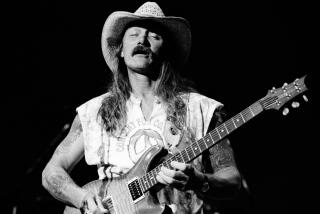‘Fillmore’ Documents Power of Allman Band
Most of the great American rock bands that surfaced in the ‘60s and ‘70s--from the Beach Boys and the Byrds to Creedence Clearwater Revival and the Doors--drew most of their strength and appeal from their material.
The Allman Brothers Band also had worthy songs, but the group’s real power rested in the way it played the songs. Like Cream and the Jimi Hendrix Experience, the Allmans demonstrated the power of instrumental assault in rock.
The just-released “The Fillmore Concerts,” an excellent two-disc set, documents that power.
The Allmans’ specialty: a blues-based blend of country, gospel, jazz and soul that seemed lean and pure despite jams that sometimes lasted, on stage and on records, 20 minutes or more. It’s a style that largely defined Southern rock.
Gregg Allman was a first-rate singer, but the real voice of the Georgia-based group rested in the soulful guitar interchanges of Duane Allman and Dickey Betts as well as the rhythms of bassist Berry Oakley and drummer-percussionists Jaimoe and Butch Trucks.
Though the band continued to be a formidable attraction--enjoying its greatest commercial success, in fact, in 1973 when its “Brothers and Sisters” album spent five weeks atop the sales charts--the group’s core lineup ended when Duane Allman was killed in a 1971 motorcycle accident. The band also lost Oakley in a motorcycle accident the following year.
The group was perhaps at its instrumental peak in 1971 when it played a series of shows at Bill Graham’s Fillmore East in New York. Four concerts in March were the basis for “The Allman Brothers Band at Fillmore East.” The double album, containing such Allman classics as “Statesboro Blues” and “Whipping Post,” is widely regarded as one of the most prized live collections ever.
Taking advantage of the CD length, “The Fillmore Concerts” offers nearly twice as much music as the 1971 album. It features versions of all eight songs from the original album plus five performances--including the essential “One Way Out”--that appeared on subsequent albums or anthologies.
But the added material isn’t the only feature of this set. Tom Dowd, who produced the 1971 album, went back into the studio and remixed the tapes with today’s technology.
In the liner notes, Dowd reflects on the differences the equipment made. “Each night after the shows, the band and I would boogie up to Atlantic studios, listen to the tapes of the shows, and make some instant decisions,” he said.
“But listening to these remixed tapes just blew my mind. You can hear Gregg and Duane locking, you can hear Duane and Dickey locking, you can hear little percussion parts tucked away. You can hear all this stuff that even I didn’t know existed. Now, for the first time, I can hear it more like it really sounded live.”
More to Read
The biggest entertainment stories
Get our big stories about Hollywood, film, television, music, arts, culture and more right in your inbox as soon as they publish.
You may occasionally receive promotional content from the Los Angeles Times.










